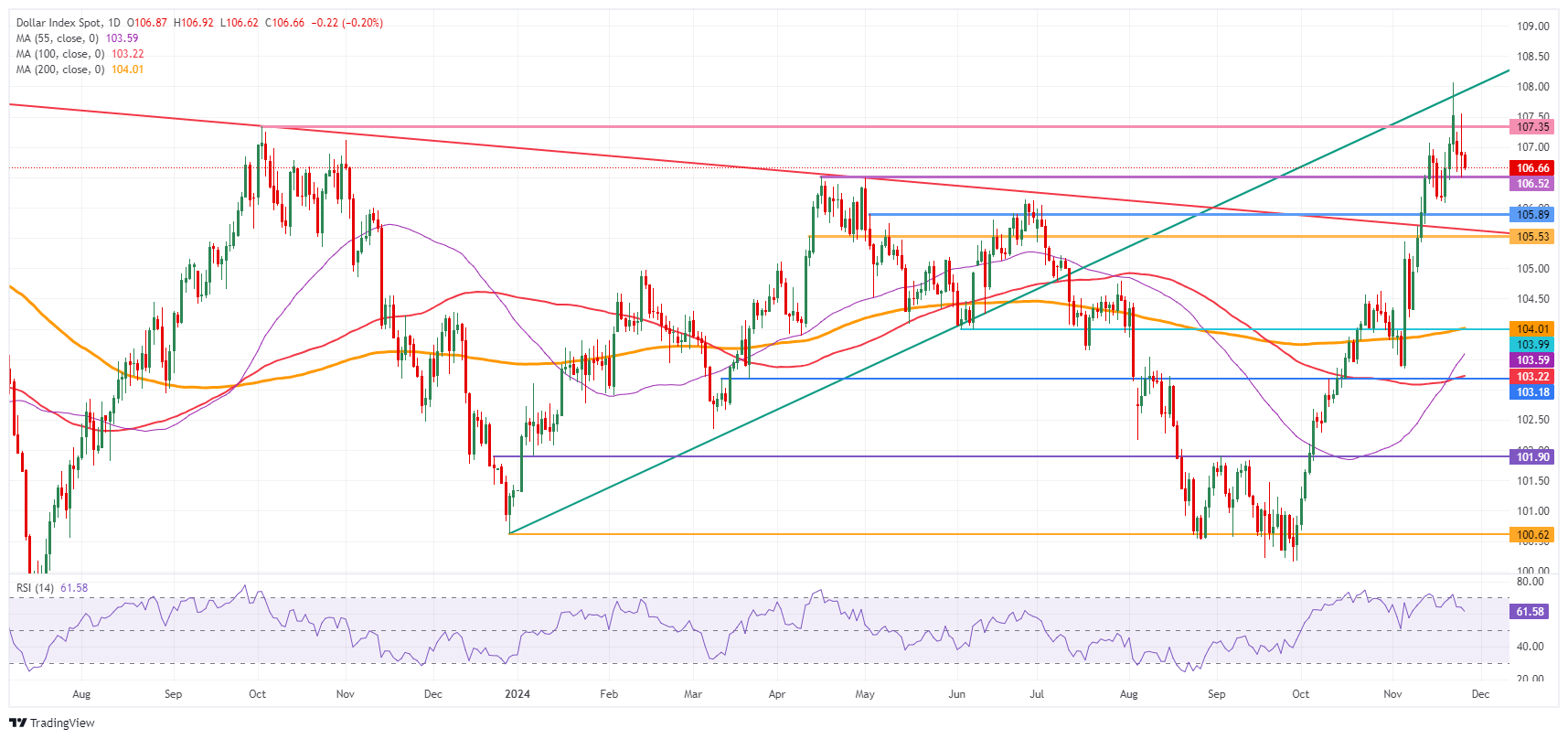- The US Dollar dips lower under profit taking ahead of Thanksgiving.
- With Thanksgiving and Black Friday ahead, Wednesday will release three days’s worth of economic data.
- The US Dollar Index extends this week’s decline and dips to the lower end of 106.00.
The US Dollar (USD) is dropping lower this Wednesday after some major US economic data points were released. With the shortened trading week, the US Gross Domestic Product, the Durable Goods and the Personal Consumption Expenditures data has been moved up, to Wednesday. The third quarter Gross Domestic Product (GDP) print came in as no surprise and was in line of expectations, where Durable Goods came in at 0.2%, far below the expected 0.5% ahead of the busiest shopping season of the US.
The main pivotal data that remained for this Wednesday was the Personal Consumption Expenditures (PCE) Price Index for October, the preferred inflation gauge for the Federal Reserve (Fed). Both the Core and Headline prints for both the yearly and monthly component fell in line of expectations. This confirms the 50-50 odds for either a rate cut or rate pauze in the upcoming December meeting.
Daily digest market movers: PCE snooze fest
- Traders were glued to their screens for some major economic data releases on the US economy.
- A revised reading of the US Gross Domestic Product for the third quarter:
- Headline GDP came in as expected at 2.8%.
- The Price Index component ticked up to 1.9%, from the previous 1.8%.
- The PCE segment remained unchanged at 1.5%.
- Weekly Initial Jobless Claims rose by 213,000, much less than the expected 217,000.
- Durable Goods Orders for October fell to 0.2%, below the expected 0.5%. Goods without transportation are flirting with contraction and fell to only 0.1%, where 0.2% was expected.
- A revised reading of the US Gross Domestic Product for the third quarter:
- At 15:00 GMT, the Fed’s preferred inflation gauge has released, the Personal Consumption Expenditures (PCE) for October:
- The monthly headline PCE came in at 0.2%, as expected.
- The monthly core PCE portrayed a steady growth of 0.3% compared to the previous month.
- On a yearly basis, the headline inflation accelerated to 2.3% in October from 2.1% a month earlier. The core PCE went to 2.8%, stronger than the former release of 2.7%.
- Equities are struggling with both European equities and US futures are falling in red numbers after the US GDP and Durable Goods release.
- The CME FedWatch Tool is pricing in another 25 basis points (bps) rate cut by the Fed at the December 18 meeting by 66.5%. A 33.5% chance is for rates to remain unchanged. The Fed Minutes have helped the rate cut odds for December to move higher.
- The US 10-year benchmark rate trades at 4.27%, substantially lower from the high printed two weeks ago of 4.50% on November 15.
US Dollar Index Technical Analysis: Taking profit before Thanksgiving holidays
The US Dollar Index (DXY) is softening a touch ahead of the last important data release for this broken week with the Thanksgiving public holiday ahead. Experienced traders will know that it will be nearly impossible to trade on the back of the economic data release with too many moving parts influencing the direction of the Greenback and other asset classes. Besides that, a very valid argument can be made here that the Greenback has had a very profitable rally, with US traders ready to cash in before diving into their turkey.
The fresh two-year high at 108.07 seen on Friday is the first level to beat. Further up, the 109.00 big figure level is the next one in line. The support from October 2023 at 109.36 is certainly a level to watch out for on the topside.
Support comes in around 106.52, the double top from May. A touch lower, the pivotal 105.53 (April 11 high) should avoid any downturns towards 104.00. Should the DXY fall all the way towards 104.00, the big figure and the 200-day Simple Moving Average at 103.98 should catch any falling knife formation.
US Dollar Index: Daily Chart
Fed FAQs
Monetary policy in the US is shaped by the Federal Reserve (Fed). The Fed has two mandates: to achieve price stability and foster full employment. Its primary tool to achieve these goals is by adjusting interest rates. When prices are rising too quickly and inflation is above the Fed’s 2% target, it raises interest rates, increasing borrowing costs throughout the economy. This results in a stronger US Dollar (USD) as it makes the US a more attractive place for international investors to park their money. When inflation falls below 2% or the Unemployment Rate is too high, the Fed may lower interest rates to encourage borrowing, which weighs on the Greenback.
The Federal Reserve (Fed) holds eight policy meetings a year, where the Federal Open Market Committee (FOMC) assesses economic conditions and makes monetary policy decisions. The FOMC is attended by twelve Fed officials – the seven members of the Board of Governors, the president of the Federal Reserve Bank of New York, and four of the remaining eleven regional Reserve Bank presidents, who serve one-year terms on a rotating basis.
In extreme situations, the Federal Reserve may resort to a policy named Quantitative Easing (QE). QE is the process by which the Fed substantially increases the flow of credit in a stuck financial system. It is a non-standard policy measure used during crises or when inflation is extremely low. It was the Fed’s weapon of choice during the Great Financial Crisis in 2008. It involves the Fed printing more Dollars and using them to buy high grade bonds from financial institutions. QE usually weakens the US Dollar.
Quantitative tightening (QT) is the reverse process of QE, whereby the Federal Reserve stops buying bonds from financial institutions and does not reinvest the principal from the bonds it holds maturing, to purchase new bonds. It is usually positive for the value of the US Dollar.
Information on these pages contains forward-looking statements that involve risks and uncertainties. Markets and instruments profiled on this page are for informational purposes only and should not in any way come across as a recommendation to buy or sell in these assets. You should do your own thorough research before making any investment decisions. FXStreet does not in any way guarantee that this information is free from mistakes, errors, or material misstatements. It also does not guarantee that this information is of a timely nature. Investing in Open Markets involves a great deal of risk, including the loss of all or a portion of your investment, as well as emotional distress. All risks, losses and costs associated with investing, including total loss of principal, are your responsibility. The views and opinions expressed in this article are those of the authors and do not necessarily reflect the official policy or position of FXStreet nor its advertisers. The author will not be held responsible for information that is found at the end of links posted on this page.
If not otherwise explicitly mentioned in the body of the article, at the time of writing, the author has no position in any stock mentioned in this article and no business relationship with any company mentioned. The author has not received compensation for writing this article, other than from FXStreet.
FXStreet and the author do not provide personalized recommendations. The author makes no representations as to the accuracy, completeness, or suitability of this information. FXStreet and the author will not be liable for any errors, omissions or any losses, injuries or damages arising from this information and its display or use. Errors and omissions excepted.
The author and FXStreet are not registered investment advisors and nothing in this article is intended to be investment advice.
Recommended content
Editors’ Picks

US PCE matched consensus in October – LIVE
The U.S. Department of Commerce announced that annual headline Personal Consumption Expenditures (PCE) inflation climbed to 2.3% in October, with core PCE inflation—a key measure excluding food and energy—rising slightly higher at 2.8% over the same period.

EUR/USD retreats from tops post-US PCE, back near 1.0540
The bearish sentiment in the US Dollar remains in place and supports EUR/USD's constructive outlook, keeping it in the 1.0540 region after the release of US inflation data, as measured by the PCE, on Wednesday.

GBP/USD recedes to 1.2640 on US PCE data
GBP/USD remains positively oriented in the 1.2640 zone as the Greenback experiences a marked pullback following the PCE inflation release.

Gold remains sidelined near $2,640 following US inflation prints
Gold remains on the positive foot near $2,640 per troy ounce, as US inflation data matched initial estimates in October, while US yields display a negative performance across the curve.

Eurozone PMI sounds the alarm about growth once more
The composite PMI dropped from 50 to 48.1, once more stressing growth concerns for the eurozone. Hard data has actually come in better than expected recently – so ahead of the December meeting, the ECB has to figure out whether this is the PMI crying wolf or whether it should take this signal seriously. We think it’s the latter.

Best Forex Brokers with Low Spreads
VERIFIED Low spreads are crucial for reducing trading costs. Explore top Forex brokers offering competitive spreads and high leverage. Compare options for EUR/USD, GBP/USD, USD/JPY, and Gold.
